Skiing is an exhilarating sport that combines speed, agility, and the breathtaking beauty of snow-covered landscapes. Whether you're carving down groomed slopes or exploring the backcountry, having the right gear is essential for both performance and safety. One often overlooked piece of equipment is the ski pole. Choosing the right ski poles can enhance your skiing experience, providing support, balance, and rhythm to your turns. In this comprehensive guide, we'll explore how to select the perfect ski poles for your skiing adventures.
Key Takeaways:
- Understanding the right ski pole length and features is crucial for optimal performance and comfort.
- Ski pole materials and design can significantly affect your skiing experience, from weight to durability.
- Personal preference, skiing style, and terrain are important considerations when selecting ski poles.
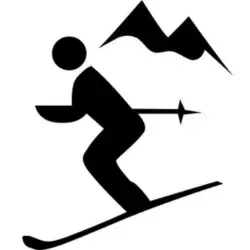
Understanding the Basics of Ski Poles
When it comes to skiing, many focus on skis and ski boots, but ski poles are an integral part of your ski gear. They aid in maintaining balance, timing your turns, and propelling you across flat terrain. The right ski poles can make a significant difference in your skiing efficiency and enjoyment.
The Importance of the Right Ski Pole Length
Choosing the right ski pole length is paramount for proper form and function on the slopes. Too long or too short can throw off your balance and make skiing more difficult. A general rule of thumb is to turn the ski pole upside down, grab it below the ski pole basket, and plant the grip on the ground. Your elbow should be at a 90-degree angle. However, this is just a starting point, and adjustments may be necessary based on personal preference and skiing style.
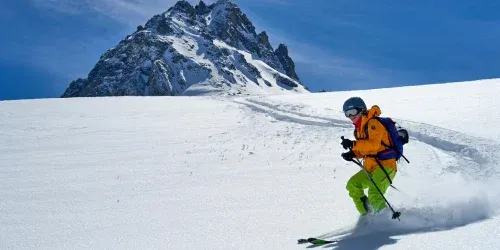
Selecting the Right Ski Poles for Your Style
Ski poles are not one-size-fits-all. Different types of skiing require different pole characteristics. Alpine ski poles differ from those used by backcountry or freestyle skiers. Alpine poles are typically straight, while those designed for freestyle skiers might have a slight bend to avoid catching during tricks.
For Alpine Ski Racers
Ski racers often prefer longer poles for a more aggressive pole plant and to aid in aerodynamics when tucking. The right length for racing poles can be determined by a size chart specific to racing or by consulting with a coach to find the best fit for your racing style.
The Role of Ski Pole Baskets
Ski pole baskets are not merely decorative; they serve a functional purpose. They prevent the pole from sinking too deeply into the snow, which is especially important in powder conditions. Some poles come with interchangeable baskets, allowing you to switch between smaller baskets for hardpack snow and larger powder baskets for off-piste adventures.
Choosing Basket Types for Different Conditions
For those who ski in a variety of snow conditions, having interchangeable baskets can be a game-changer. Powder baskets are larger to provide more surface area and prevent sinking, while smaller baskets are ideal for groomed runs or hardpack snow where less resistance is needed.
Materials Matter: Shaft Materials and Durability
The materials from which ski poles are made can greatly influence their weight, durability, and feel. Aluminum poles are common and provide a good balance of strength and cost-effectiveness. Carbon fiber poles are lighter and can reduce arm fatigue, but they are also more expensive and can be less durable in some cases.
Eco-Friendly and Innovative Materials
In recent years, there has been a push for more eco-friendly materials in ski gear. Some manufacturers are now offering poles made from sustainable resources or recycled materials without compromising on strength or performance.
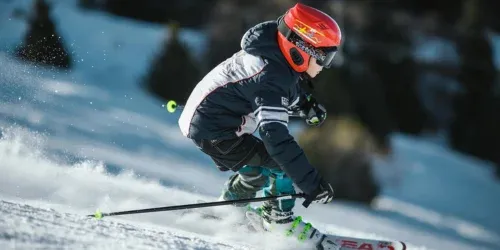
Grip and Comfort: Ski Pole Grips
A good grip on your ski poles is essential for control and comfort. Ski pole grips come in various materials and designs, from soft rubber to ergonomically shaped handles. Some grips are designed to work well with ski gloves, providing a secure hold even in cold and wet conditions.
Finding the Right Size Ski Poles for Your Height
When choosing ski poles, it's crucial to find the right size for your height to ensure maximum comfort and efficiency on the slopes. A common method to determine the correct size is to flip the pole upside down, grab it below the basket, and see if your elbow forms a 90-degree angle. If you're an intermediate skier or above, you might prefer a longer pole for greater leverage during turns, especially if you're venturing off piste. However, beginners might benefit from shorter poles as they provide better balance and control while learning.
To measure the pole size accurately, use a tape measure to gauge the distance from the ground to your elbow when your arm is bent at a right angle. This measurement will give you a good starting point. Remember, many poles come in increments of 5 centimeters, so you may need to round up or down slightly. The right poles should feel like a natural extension of your arms, allowing you to plant them firmly without overreaching or bending too much.
The Benefits of a Shorter Pole for Intermediate Skiers
When it comes to intermediate skiers looking to refine their technique, the length of the ski pole can make a significant difference. A shorter pole can facilitate quicker, more agile movements, allowing skiers to navigate through moguls and perform short-radius turns with greater ease. It's not just about maneuverability; a shorter pole can also help in maintaining proper posture, as it encourages skiers to keep their hands forward and center of gravity over the skis, which is crucial for developing advanced skiing skills.
Moreover, using a shorter pole can be particularly beneficial when tackling steeper terrain. It allows for better balance and control as skiers can plant their poles without overreaching, which can throw off their stance. Intermediate skiers often find that a slight reduction in pole length can lead to a noticeable improvement in their overall performance on the slopes. It's a simple adjustment that can yield significant results, making the transition from intermediate to advanced skiing smoother and more enjoyable.
Embracing Eco-Friendly Ski Pole Options
In recent years, the ski industry has seen a surge in eco-friendly innovations, and ski poles are no exception. Eco-friendly ski poles are typically made from sustainable materials such as bamboo or recycled aluminum, offering a greener alternative to traditional options. These poles not only reduce the environmental impact but also provide the performance and durability skiers expect. Bamboo poles, for instance, are not only sustainable but also naturally dampen vibrations, offering a smooth skiing experience.
For environmentally conscious skiers, choosing eco-friendly ski poles is a step towards minimizing their carbon footprint while enjoying the slopes. These poles often come from companies that are committed to sustainable practices, which may include using recycled materials for the grips and straps or ensuring that the production process is energy efficient. By opting for eco-friendly ski poles, skiers can make a positive impact on the environment without compromising on quality or performance. It's a win-win for both the planet and the powder enthusiasts.
The Impact of Pole Material on Performance
Ski poles are crafted from different materials, each with its own set of benefits. An aluminum pole is a popular choice for its balance of weight, durability, and cost-effectiveness. These poles are ideal for most recreational skiers and offer a good level of stiffness for downhill skiing. On the other hand, carbon fiber poles are lighter and can reduce arm fatigue, but they are also more brittle and may not withstand rough treatment as well as an aluminum pole.
For those who prioritize sustainability, eco-friendly poles made from renewable materials like bamboo are becoming more available. These poles are not only environmentally conscious but also provide a unique flex and feel that some skiers prefer. When selecting the right poles, consider the different materials and how they align with your skiing style and values. Whether you opt for the durability of aluminum or the lightweight performance of carbon fiber, the right choice will enhance your skiing experience.
The Right Grip for Your Hand Size
When buying ski poles, it's important to consider the size and shape of the grip. It should fit comfortably in your hand and allow for a firm hold without straining your fingers. This can prevent fatigue and improve your overall control when planting turns.
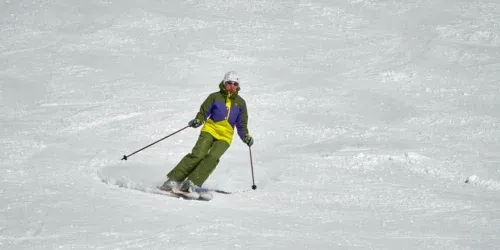
The Convenience of Adjustable Poles
Adjustable poles, or telescoping poles, offer versatility for skiers who tackle a range of terrains or for those who share poles among family members. These poles can be adjusted to different lengths to suit the skier's height and the terrain, making them a practical choice for growing children or for skiers who enjoy both alpine and backcountry skiing.
When to Consider Telescoping Poles
Telescoping poles are particularly useful for backcountry skiers who may encounter varying slope angles and need to adjust their pole length accordingly. They are also convenient for travel, as they can be collapsed to fit into luggage or a ski bag.
The Debate Over Ski Pole Straps
Ski pole straps are designed to prevent poles from being dropped or lost, but there is a debate over their safety. Some argue that straps can lead to wrist injuries in a fall, while others find them essential for keeping poles handy. It's a matter of personal preference, and some poles offer easy-to-release straps for added safety.
To Strap or Not to Strap
If you choose to use ski pole straps, ensure they are adjusted correctly so that you can easily slip your hand in and out. Some skiers prefer to forego straps altogether, especially in terrain where falls are more likely, to reduce the risk of injury.
Weight Considerations for Frequent Use
For skiers who spend long days on the mountain, the weight of the poles can become a significant factor. Lighter poles can reduce arm fatigue, allowing for more energy to be focused on skiing. However, lighter materials may come with a higher price tag, so it's important to balance weight preferences with budget considerations.
Balancing Weight and Durability
While carbon fiber poles offer the advantage of being lightweight, they may not be as durable as aluminum poles. It's important to consider how often you ski and in what conditions when deciding on the weight and material of your poles.
Personal Preference and Final Selection
Ultimately, choosing the right ski poles comes down to personal preference. Factors such as grip comfort, pole weight, and the feel of the pole plant are subjective and can only be determined by trying out different poles. Visiting a ski shop and speaking with knowledgeable staff can help you narrow down your options.
Trusting Your Instincts
After considering all the technical aspects, don't underestimate the importance of how the poles feel in your hands. Trust your instincts and choose poles that feel like a natural extension of your arms, enhancing your skiing rather than hindering it.
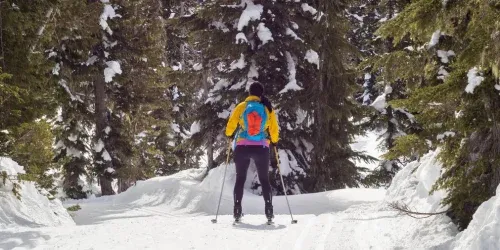
Summary
Selecting the right ski poles involves considering a variety of factors, including length, material, grip, and personal preference. The correct length ensures proper balance and technique, while the material can affect the weight and durability of the poles. Interchangeable baskets and adjustable lengths can offer versatility for different skiing conditions. Ultimately, the best ski poles are the ones that feel right for you and complement your skiing style.

FAQs
How do I know if my ski poles are the right length?
Invert the ski pole and grab it below the basket. When you place the grip on the ground, your arm should form a 90-degree angle. Adjustments may be needed based on personal preference and skiing style.
Are adjustable ski poles worth it?
Adjustable poles are versatile and can be a great investment for skiers who encounter different terrains or for families with growing children. They are also convenient for travel.
Should I use ski pole straps?
This is a personal choice. Straps can prevent losing poles but may pose a risk of wrist injury during a fall. Some poles come with easy-release straps for added safety. Consider your skiing environment and personal comfort when deciding.









